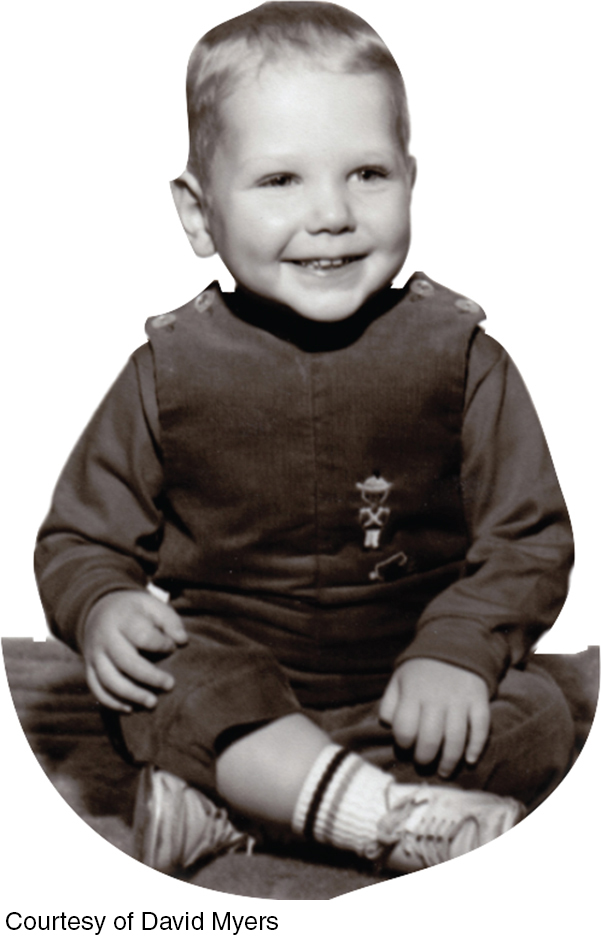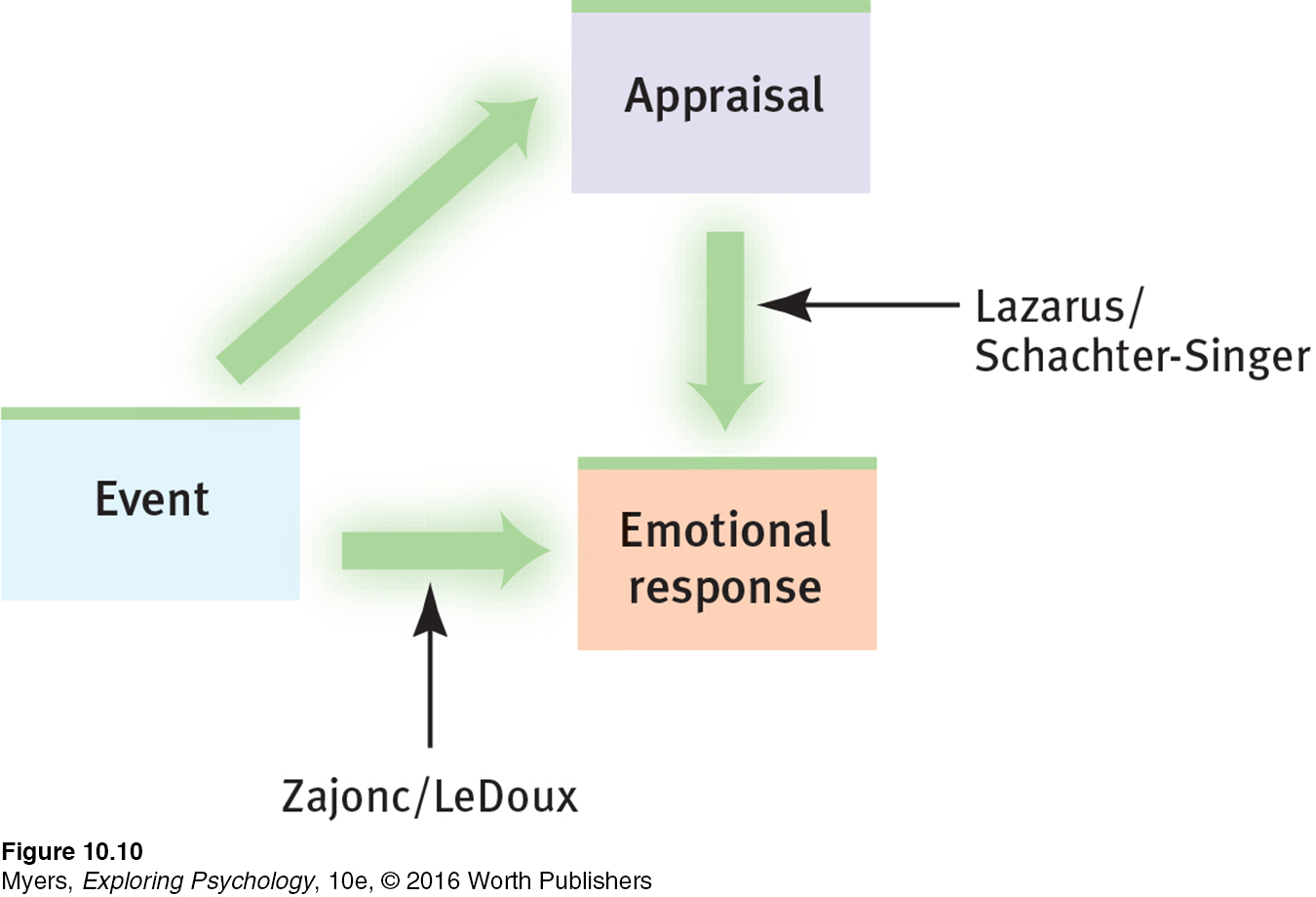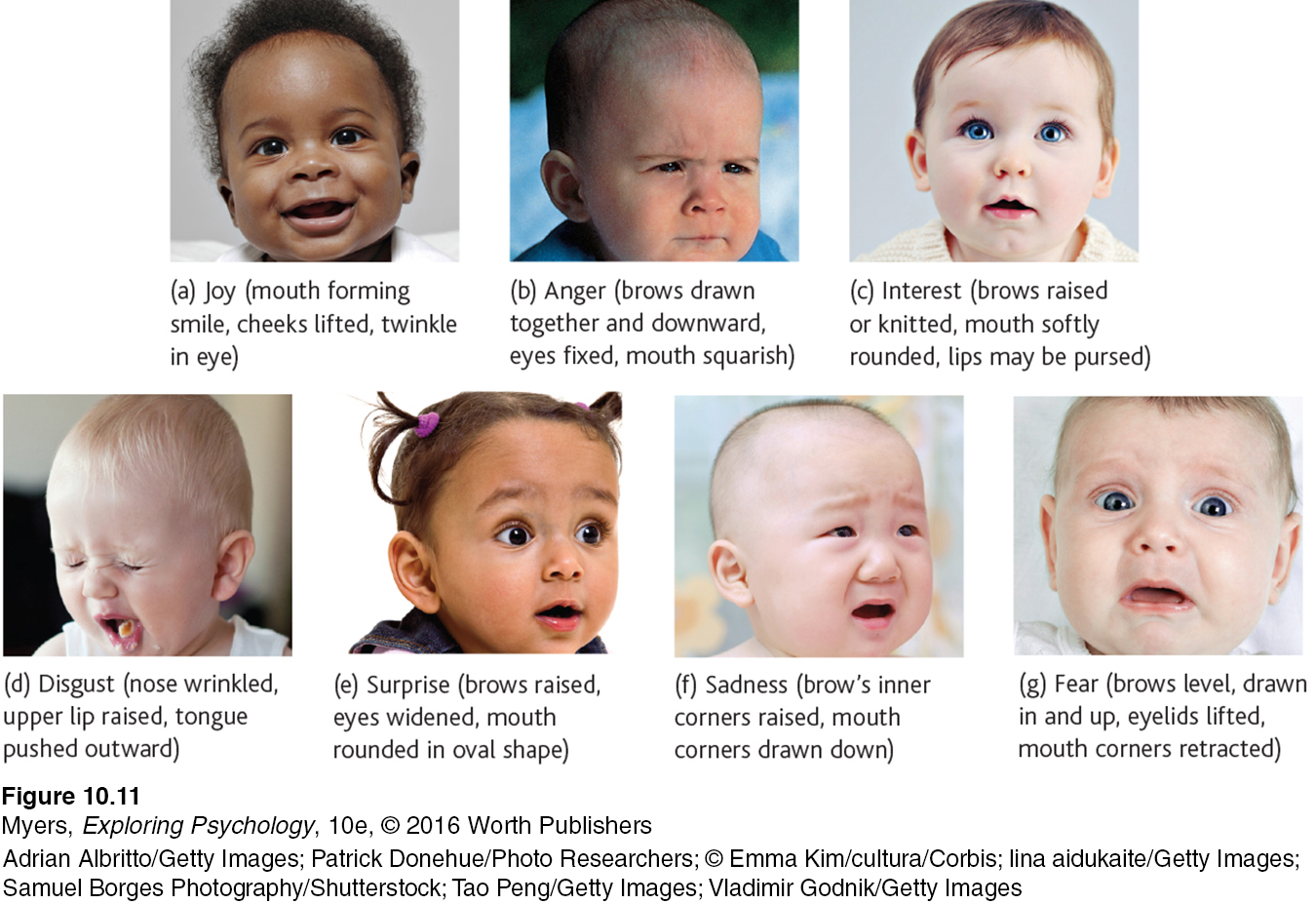10.3 Theories and Physiology of Emotion
Emotion: Arousal, Behavior, and Cognition
10-
Not only emotion, but most psychological phenomena (vision, sleep, memory, sex, and so forth) can be approached these three ways—
Motivated behavior is often connected to powerful emotions. My [DM’s] own need to belong was unforgettably disrupted one day. I went to a huge store and brought along Peter, my toddler first-
With mild anxiety, I peered around one end of the customer service counter. No Peter in sight. With slightly more anxiety, I peered around the other end. No Peter there, either. Now, with my heart accelerating, I circled the neighboring counters. Still no Peter anywhere. As anxiety turned to panic, I began racing up and down the store aisles. He was nowhere to be found. The alerted store manager used the public-

But then, as I passed the customer service counter yet again, there he was, having been found and returned by some obliging customer. In an instant, the arousal of terror spilled into ecstasy. Clutching my son, with tears suddenly flowing, I found myself unable to speak my thanks and stumbled out of the store awash in grateful joy.
Emotions are subjective. But they are real, says researcher Lisa Feldman Barrett (2012, 2013): “My experience of anger is not an illusion. When I’m angry, I feel angry. That’s real.” Where do our emotions come from? Why do we have them? What are they made of?
Emotions are our body’s adaptive response. They support our survival. When we face challenges, emotions focus our attention and energize our actions (Cyders & Smith, 2008). Our heart races. Our pace quickens. All our senses go on high alert. Receiving unexpected good news, we may find our eyes tearing up. We raise our hands triumphantly. We feel exuberance and a newfound confidence. Yet negative and prolonged emotions can harm our health.
emotion a response of the whole organism, involving (1) physiological arousal, (2) expressive behaviors, and (3) conscious experience.
As my panicked search for Peter illustrates, emotions are a mix of:
bodily arousal (heart pounding).
expressive behaviors (quickened pace).
conscious experience, including thoughts (“Is this a kidnapping?”) and feelings (panic, fear, joy).
The puzzle for psychologists is figuring out how these three pieces fit together. To do that, the first researchers of emotion considered two big questions:
A chicken-
and- egg debate: Does your bodily arousal come before or after your emotional feelings? (Did I first notice my racing heart and faster step, and then feel terror about losing Peter? Or did my sense of fear come first, stirring my heart and legs to respond?) How do thinking (cognition) and feeling interact? Does cognition always come before emotion? (Did I think about a kidnapping threat before I reacted emotionally?)
Historical emotion theories, as well as current research, have sought to answer these questions.
Historical Emotion Theories
The psychological study of emotion began with the first question: How do bodily responses relate to emotions? Two historical theories provided different answers.

James-Lange theory the theory that our experience of emotion is our awareness of our physiological responses to an emotion-
JAMES-
Cannon-Bard theory the theory that an emotion-
CANNON-
If our bodily responses and emotional experiences occur simultaneously and independently, as the Cannon-
But our emotions also involve cognition (Averill, 1993; Barrett, 2006). Here we arrive at psychology’s second big emotion question: How do thinking and feeling interact? Whether we fear the man behind us on the dark street depends entirely on whether we interpret his actions as threatening or friendly.
RETRIEVE IT
Question
According to the Cannon-
Schachter-Singer’s Two Factors: Arousal + Label = Emotion
10-9 To experience emotions, must we consciously interpret and label them?
two-factor theory the Schachter-Singer theory that to experience emotion one must (1) be physically aroused and (2) cognitively label the arousal.
Stanley Schachter and Jerome Singer (1962) demonstrated that how we appraise our experiences matters greatly. Our physical reactions and our thoughts (perceptions, memories, and interpretations) together create emotion. In their two-factor theory, emotions have two ingredients: physical arousal and cognitive appraisal. An emotional experience, they argued, requires a conscious interpretation of arousal.
Consider how arousal spills over from one event to the next. Imagine arriving home after an invigorating run and finding a message that you got a longed-
To explore this spillover effect, Schachter and Singer injected college men with the hormone epinephrine, which triggers feelings of arousal. Picture yourself as a participant: After receiving the injection, you go to a waiting room, where you find yourself with another person (actually an accomplice of the experimenters) who is acting either euphoric or irritated. As you observe this person, you begin to feel your heart race, your body flush, and your breathing become more rapid. If you had been told to expect these effects from the injection, what would you feel? The actual volunteers felt little emotion—

This discovery—
The point to remember: Arousal fuels emotion; cognition channels it.
RETRIEVE IT
Question
According to Schachter and Singer, two factors lead to our experience of an emotion: (1) physiological arousal and (2) appraisal.
 For a 4-minute demonstration of the relationship between arousal and cognition, see LaunchPad’s Video: Emotion = Arousal Plus Interpretation, below.
For a 4-minute demonstration of the relationship between arousal and cognition, see LaunchPad’s Video: Emotion = Arousal Plus Interpretation, below.
Zajonc, LeDoux, and Lazarus: Does Cognition Always Precede Emotion?
But is the heart always subject to the mind? Must we always interpret our arousal before we can experience an emotion? Robert Zajonc (1923–
For example, when people repeatedly view stimuli flashed too briefly for them to interpret, they come to prefer those stimuli. Unaware of having previously seen them, they nevertheless like them. We have an acutely sensitive automatic radar for emotionally significant information; even a subliminally flashed stimulus can prime us to feel better or worse about a follow-
Neuroscientists are charting the neural pathways of emotions (Ochsner et al., 2009). Our emotional responses can follow two different brain pathways. Some emotions (especially more complex feelings like hatred and love) travel a “high road.” A stimulus following this path would travel (by way of the thalamus) to the brain’s cortex (FIGURE 10.9a below). There, it would be analyzed and labeled before the response command is sent out, via the amygdala (an emotion-
But sometimes our emotions (especially simple likes, dislikes, and fears) take what Joseph LeDoux (2002) has called the “low road,” a neural shortcut that bypasses the cortex. Following the low road, a fear-
The amygdala sends more neural projections up to the cortex than it receives back, which makes it easier for our feelings to hijack our thinking than for our thinking to rule our feelings (LeDoux & Armony, 1999). Thus, in the forest, we can jump at the sound of rustling bushes nearby, leaving it to our cortex to decide later whether the sound was made by a snake or by the wind. Such experiences support Zajonc’s belief that some of our emotional reactions involve no deliberate thinking.

Emotion researcher Richard Lazarus (1991, 1998) conceded that our brain processes vast amounts of information without our conscious awareness, and that some emotional responses do not require conscious thinking. Much of our emotional life operates via the automatic, speedy low road. But, he asked, how would we know what we are reacting to if we did not in some way appraise the situation? The appraisal may be effortless and we may not be conscious of it, but it is still a mental function. To know whether a stimulus is good or bad, the brain must have some idea of what it is (Storbeck et al., 2006). Thus, said Lazarus, emotions arise when we appraise an event as harmless or dangerous, whether we truly know it is or not. We appraise the sound of the rustling bushes as the presence of a threat. Later, we realize that it was “just the wind.”
So, as Zajonc and LeDoux have demonstrated, some emotional responses—

But our feelings about politics are also subject to our conscious and unconscious information processing—
Summary of Emotion Theories
| Theory | Explanation of Emotions | Example |
|---|---|---|
| James- |
Emotions arise from our awareness of our specific bodily responses to emotion- |
We observe our heart racing after a threat and then feel afraid. |
| Cannon- |
Emotion- |
Our heart races at the same time that we feel afraid. |
| Schachter- |
Our experience of emotion depends on two factors: general arousal and a conscious cognitive label. | We may interpret our arousal as fear or excitement, depending on the context. |
| Zajonc; LeDoux | Some embodied responses happen instantly, without conscious appraisal. | We automatically feel startled by a sound in the forest before labeling it as a threat. |
| Lazarus | Cognitive appraisal (“Is it dangerous or not?”)—sometimes without our awareness— |
The sound is “just the wind.” |
RETRIEVE IT
Question
Emotion researchers have disagreed about whether emotional responses occur in the absence of cognitive processing. How would you characterize the approach of each of the following researchers: Zajonc, LeDoux, Lazarus, Schachter, and Singer?
Embodied Emotion
Whether you are falling in love or grieving a death, you need little convincing that emotions involve the body. Feeling without a body is like breathing without lungs. Some physical responses are easy to notice. Other emotional responses we experience without awareness. Before examining our physical responses to specific emotions, consider another big question: How many distinct emotions are there?
The Basic Emotions
10-
Carroll Izard (1977) isolated 10 basic emotions (joy, interest-

Emotions and the Autonomic Nervous System
10-
In a crisis, the sympathetic division of your autonomic nervous system (ANS) mobilizes your body for fight or flight (FIGURE 10.12). It triggers your adrenal glands to release the stress hormones epinephrine (adrenaline) and norepinephrine (noradrenaline). To provide energy, your liver pours extra sugar into your bloodstream. To help burn the sugar, your respiration increases to supply needed oxygen. Your heart rate and blood pressure increase. Your digestion slows, diverting blood from your internal organs to your muscles. With blood sugar driven into the large muscles, running becomes easier. Your pupils dilate, letting in more light. To cool your stirred-

“Fear lends wings to his feet.”
Virgil, Aeneid, 19 B.C.E.
When the crisis passes, the parasympathetic division of your ANS gradually calms your body, as stress hormones slowly leave your bloodstream. After your next crisis, think of this: Without any conscious effort, your body’s response to danger is wonderfully coordinated and adaptive—
The Physiology of Emotions
10-
Imagine conducting an experiment measuring the physiological responses of emotion. In each of four rooms, you have someone watching a movie: In the first, the person is viewing a horror show; in the second, an anger-

With training, you could probably pick out the bored viewer. But discerning physiological differences among fear, anger, and sexual arousal is much more difficult (Barrett, 2006). Different emotions can share common biological signatures.
A single brain region can also serve as the seat of seemingly different emotions. Consider the broad emotional portfolio of the insula, a neural center deep inside the brain. The insula is activated when we experience various negative social emotions, such as disgust. In brain scans, it becomes active when people bite into some disgusting food, smell disgusting food, think about biting into a disgusting cockroach, or feel moral disgust over a sleazy business exploiting a saintly widow (Sapolsky, 2010). Similar multitasking regions are found in other brains areas.
Yet our emotions—
“No one ever told me that grief felt so much like fear. I am not afraid, but the sensation is like being afraid. The same fluttering in the stomach, the same restlessness, the yawning. I keep on swallowing.”
C. S. Lewis, A Grief Observed, 1961
Some of our emotions also differ in their brain circuits (Panksepp, 2007). Observers watching fearful faces showed more amygdala activity than did other observers who watched angry faces (Whalen et al., 2001). Brain scans and EEG recordings show that emotions also activate different areas of the brain’s cortex. When you experience negative emotions such as disgust, your right prefrontal cortex tends to be more active than the left. Depression-
Positive moods tend to trigger more left frontal lobe activity. People with positive personalities—
To sum up, we can’t easily see differences in emotions from tracking heart rate, breathing, and perspiration. But facial expressions and brain activity can vary from one emotion to another. So, do we, like Pinocchio, give off telltale signs when we lie? For more on that question, see Thinking Critically About: Lie Detection.
THINKING CRITICALLY ABOUT
Lie Detection
10-
polygraph a machine, commonly used in attempts to detect lies, that measures several of the physiological responses (such as perspiration and cardiovascular and breathing changes) accompanying emotion.
Can a lie detector—a polygraph—reveal lies? Polygraphs don’t literally detect lies. Instead, they measure emotion-
Critics point out two problems: First, our physiological arousal is much the same from one emotion to another. Anxiety, irritation, and guilt all prompt similar physiological reactivity. Second, many innocent people do respond with heightened tension to the accusations implied by the critical questions (FIGURE 10.13). Many rape victims, for example, have “failed” these tests when reacting emotionally but truthfully (Lykken, 1991).

A 2002 U.S. National Academy of Sciences report noted that “no spy has ever been caught [by] using the polygraph.” It is not for lack of trying. The FBI, CIA, and U.S. Departments of Defense and Energy have tested tens of thousands of employees, and polygraph use in Europe has also increased (Meijer & Verschuere, 2010). Yet Aldrich Ames, a Russian spy within the CIA, went undetected. Ames took many “polygraph tests and passed them all,” noted Robert Park (1999). “Nobody thought to investigate the source of his sudden wealth—
A more effective lie detection approach uses a guilty knowledge test, which assesses a suspect’s physiological responses to crime-
RETRIEVE IT
Question
How do the two divisions of the autonomic nervous system affect our emotional responses?
REVIEW Theories and Physiology of Emotion
Learning Objectives
Test Yourself by taking a moment to answer each of these Learning Objective Questions (repeated here from within the chapter). Research suggests that trying to answer these questions on your own will improve your long-
Question
10-
Question
10-
Question
10-
Question
10-
Question
10-
Question
10-
Terms and Concepts to Remember
Test yourself on these terms.
Question
emotion (p. 387) James- Cannon- two- polygraph (p. 394) | the theory that our experience of emotion is our awareness of our physiological responses to an emotion- a machine, commonly used in attempts to detect lies, that measures several of the physiological responses (such as perspiration and cardiovascular and breathing changes) accompanying emotion. a response of the whole organism, involving (1) physiological arousal, (2) expressive behaviors, and (3) conscious experience. the theory that an emotion- the Schachter- |
Experience the Testing Effect
Test yourself repeatedly throughout your studies. This will not only help you figure out what you know and don’t know; the testing itself will help you learn and remember the information more effectively thanks to the testing effect.
Question 10.16
1. The theory of emotion maintains that a physiological response happens BEFORE we know what we are feeling.
Question 10.17
2. Assume that after spending an hour on a treadmill, you receive a letter saying that your scholarship request has been approved. The two-factor theory of emotion would predict that your physical arousal will
| A. |
| B. |
| C. |
| D. |
Question 10.18
3. Zajonc and LeDoux maintain that some emotional reactions occur before we have had the chance to consciously label or interpret them. Lazarus noted the importance of how we appraise events. These psychologists differ in the emphasis they place on ________ in emotional responses.
| A. |
| B. |
| C. |
| D. |
Question 10.19
4. What does a polygraph measure and why are its results questionable?
Use  to create your personalized study plan, which will direct you to the resources that will help you most in
to create your personalized study plan, which will direct you to the resources that will help you most in  .
.